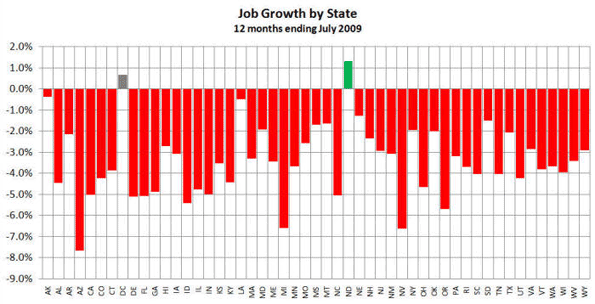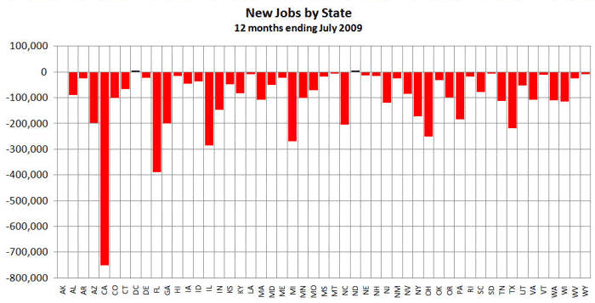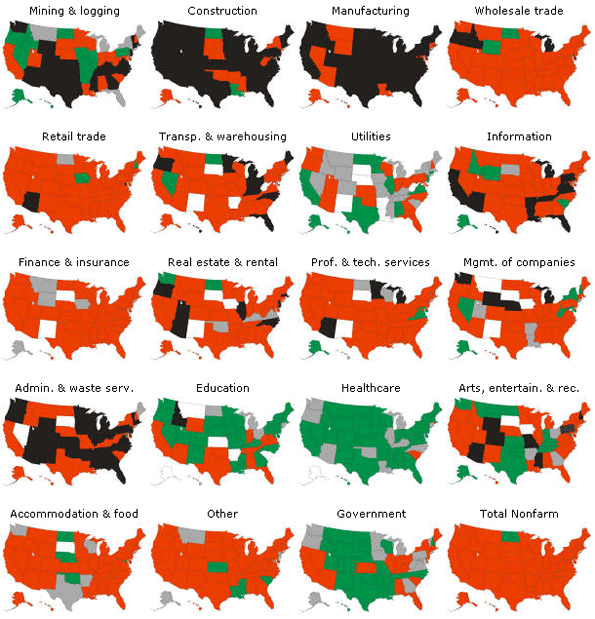NewGeography.com blogs
The Windy Citizen pointed me at coverage of metro area job losses in the recession. Here is how the 12 cities I principally cover in this blog stacked up, sorted in descending order of percentage losses:
- Detroit; 139,600 jobs; -7.5%
- Milwaukee; 44,800; -5.2%
- Cleveland; 54,100; -5.1%
- Chicago; 206,200; -4.5%
- Indianapolis; 40,200; -4.4%
- Cincinnati; 42,200; -4.0%
- Louisville; 22,900; -3.7%
- Minneapolis-St. Paul; 63,100; -3.5%
- St. Louis; 43,900; -3.3%
- Pittsburgh; 32,800 - 2.8%
- Kansas City; 21,900; -2.1%
- Columbus, Ohio; 19,600; -2.1%
A couple things that jump out of me from this are that Chicago and Indianapolis are doing far worse than conventional wisdom views of their overall economic health. Both regions are getting clobbered. The Pittsburgh story gets some additional ammunition, as does my view that Columbus is the next Midwestern star.
Recession Job Recovery
So when will the jobs come back? Nobody knows for sure, but an organization called IHS Global Insight has predicted the year in which employment will match its pre-recession peak in various major US cities (via IBJ News Talk):
- Kansas City: 2011
- Columbus: 2012
- Indianapolis: 2012
- Louisville: 2013
- Minneapolis-St. Paul: 2013
- Pittsburgh: 2013
- Chicago: 2014
- Cincinnati: 2014
- St. Louis: 2014
- Cleveland: After 2015
- Detroit: After 2015
- Milwaukee: After 2015
Visit Aaron's blog at The Urbanophile.
Soon after President Obama took office, a proposed plan to “develop federal policies to induce states and local communities to embrace ‘smart growth’ land use strategies” was announced.
This “Livable Communities Program” is intended to save land and clean up the environment. It is seen as encouraging denser housing arrangements to deter automobile use and accommodate the transit industry, according to goals set by the Secretaries of HUD, EPA and Transportation.
One potential downside to this plan comes from the transit industry’s Moving Cooler study, which argues that the Administration’s greenhouse gas reduction proposals “may result in higher housing prices, and some people might need to live in smaller homes or smaller lots than they would prefer.”
If you want to see how this might work, look at the U.K., which imposed strict land regulations in the Town and Country Planning Act in 1947. This effectively froze the supply of land for a growing population, leading to soaring house prices, particularly in the area around London.
With the land available for development frozen, house size decreased as well, leading to new British homes garnering the nickname of “Hobbit houses.” New British homes are a little more than a third as big as new U.S. homes (818 sq. feet compared the U.S.’s 2,303 sq. feet).
The question is whether or not the Federal government should be granted the ability to limit housing standards. Currently, this responsibility lands in the lap of state and local governments.
Can President Obama afford to add the President of the (Hobbit) Homeowner’s Association of the United States to his title?
The current economic recession has tarnished the Golden State’s employment opportunities in a major way.
A report released on Sunday by the California Budget Project says that two of five working-age Californians do not have a job.
The level of unemployment has not been this high since February 1977. In fact, the study found that “California now has the same amount of jobs as it did nine years ago.” The only difference? In 2000, the state was home to 3.3 million fewer working age people than today.
The nation is not faring much better, as the U.S. Labor Department reported last Friday that the nation’s jobless rate had climbed to 9.7 percent, the highest since 1983. California’s unemployment stands at over 11 percent.
Mark Hovind over at Jobbait.com released his monthly job market report, and this month he's expanded it significantly with sector-level data by state and metropolitan area.
Mark offers the numbers in an easily digestible format organized by state in color coded tables. It's a great way to get a feel for what's happening in your region or nationally.
Mark hopes this will help identify sectors with job prospects, even in regions where overall employment is declining.
Looking at total job growth, North Dakota is still the only state showing year-over-year employment growth, followed by Washington, DC.

Fastest declining states by growth rate are Arizona, Michigan, Nevada and Oregon.

Fastest declining states by sheer numbers are California, Florida, Illinois, Michigan, Ohio and Texas.
See Jobbait.com for the full report.
Dwell Magazine and inhabitat.com have combined forces to sponsor the first ever “Reburbia Design Competition,” a design competition dedicated to re-envisioning the suburbs.
Citing the current housing crisis, the sub-prime mortgage meltdown, and rising energy cost, as well as limited natural resources available to increased exurban growth, the two companies have called upon “future-forward architects” and “renegade planners” to reinvent the suburbs.
Finalists range from a “suburban airship” that facilitates eco-friendly and efficient transportation between the suburbs and the city center to mansions turned into wetlands and natural water filtration systems to freeway wind turbines. All intriguing ideas for the suburban future.
However, Sean Paige, of The American Contrarian, takes issue with the contest’s “darker side.”
“Strolling the streets of Reburbia isn't just an imaginative adventure. It also offers a revealing glimpse into the mind of the modern eco-Utopian, which melds dark apocalyptic forebodings with naive flights of fancy,” writes Paige.
He feels the contest might propel green zealots to use “levers of power” and the “force of government” to impose an “environmentally- and socially-correct vision of suburbia.”
How might this happen? Paige argues “that opportunity is there, thanks to the power granted government planners through the mania for "smart growth," new urbanism and other social engineering fads, combined with the totalitarian tendencies of those trying to "save the planet" from climate change.”
This is, of course, may be an exaggerated view. No doubt, the Gristers may say this contest would serve merely as a catalyst for developing more probable, and immediate, eco-friendly ideas but a sense of balance would not be inappropriate.
They might not have known it but Canned Heat’s classic Going Up the Country at the now 40 year-old festival was prognostic – at least in terms of where the Woodstock generation would be moving in the 2010s. John Cromartie and Peter Nelson’s recently released USDA report – Baby Boom Migration and Its Impact on Rural America – says that the baby boomers have already shown more affinity for moving to rural and small town destinations than older or younger cohorts. As many boomers end child-rearing duties, enter peak employment earnings and ponder retirement options they are now poised to significantly increase the population of 55-75 year olds in rural and small town America through 2020, with major social and economic implications for their chosen locations.
Between 2010 and 2020 boomers will make more than 200 million residential moves, most being within or between metro regions, where 80 percent of this cohort now reside. However, net migration to core metro counties is projected to decline by 643,000 during the 2010s, a dramatic shift from a population gain of 979,000 during the 90s. In the countryside the population of 55-75 year olds will increase two-thirds, from 8.6 million to 14.2 million between 2000 and 2020.
The big winners of course are those rural places with high levels of natural amenities and affordable housing that are already popular as second-home destinations. For these areas the economic future looks good as a potential influx of spending power and seasoned, footloose talent boosts development prospects.
Earlier this year, the Center for an Urban Future published an extensive report about the mounting challenges New York City faces in both retaining its middle class and elevating more low income residents into the ranks of the middle class. One of our key recommendations from that report, titled Reviving the City of Aspiration, was that "city and state officials must embrace community colleges as engines of mobility and dedicate the resources necessary to strengthen these institutions and ensure that a greater number of middle class, poor and working poor New Yorkers can attend these schools and complete their degrees."
City officials are now running with our suggestion. Today, Mayor Bloomberg announced a "Gateway to the Middle Class" plan that focuses on boosting community colleges. The mayor's proposal aims to "move more New Yorkers into the middle class by increasing the number of city residents that graduate from community colleges and training them for higher wage jobs in growing industries." The plan will invest an additional $50 million over the next four years to improve the system's quality, accessibility, affordability, and accountability.
The new attention and resources for community colleges is an important step in the right direction for the city. Our report found that community colleges in New York are overshadowed by virtually every other facet of the education system and have not received the financial support needed to effectively educate students that come from a wide variety of backgrounds and often require academic remediation. Click here to read the section of our report about community colleges, titled "A Platform For Mobility."
This should be filed with other improbable stories under the subject “beach running out of sand.” The St. Petersburg Times reports that Florida has lost population for the first time since 1946. University of Florida demographers are due to release a report that the state lost 50,000 residents in the year ended April of 2009. This is in stark contrast with the state’s addition of more than 300,000 residents in every year of the decade through 2006
The article cites housing price increases as driving out families with children and the resulting housing contraction with driving out construction workers. Florida’s housing bubble related price increases were perhaps the highest in the nation, following California.
There had already been ominous signs, with the United States Bureau of the Census reporting net outward domestic migration in 2008. As late as 2005, there had been a net gain in domestic migration of 267,000.
Mark Hovind at Jobbait.com has released another fascinating set of maps and data on industry employment trends by state over the past few months. Here's a taste:
The maps below show the employment trends by state and industry sector for the 12 months ending June 2009 (July will be available August 21). Green is growing faster than the workforce. Grey is growing slower. Red is declining. Black is declining more than 8%. White is not available.

Head over to Jobbait.com for the full analysis.
On-board sequestration could make zero carbon dioxide emission petroleum cars possible, according to research conducted by Dr. Andrei Federov and David Damm at the Woodruff School of Mechanical Engineering at Georgia Tech. According to Science Daily:
…the Georgia Tech team outlines an economically feasible strategy for processing fossil or synthetic, carbon-containing liquid fuels that allows for the capture and recycling of carbon at the point of emission. In the long term, this strategy would enable the development of a sustainable transportation system with no carbon emission.
Ultimately, the approach would involve carbon capture within petroleum vehicles. The petroleum would be processed into hydrogen, for propulsion and carbon dioxide. The carbon dioxide would be converted, on board, to liquid fuel and removed at gasoline stations. The liquid fuel would then be sent to power plants, where it would be used to produce electricity. As the necessary infrastructure is being developed, the captured carbon dioxide would be removed at gasoline stations and “sequestered in geologic formations, under the ocean or in solid carbonite form.”
This breakthrough demonstrates that it is not necessary to target the automobile or the automotive lifestyle that pervades modern living to achieve sufficient reductions in greenhouse gases. This is particularly important, given the imperative for maintaining economic growth and employment growth, which is closely linked to high levels of personal mobility.
The research was financed by the United States federal government and the Georgia Tech “Creating Energy Options” program.
|















